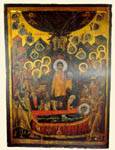|
|
| Portable Icons |
16th and 18th c. Protaton, iconostasis Wood, egg tempera, 148 x 109.5 cm |
|

|
The crowded scene of the Koimesis is an admirably balanced composition, diversified with numerous minor departures from strict symmetry, and with figures displaying a variety of poses, movements, and gestures. In the foreground is the deathbed, with the Virgin positioned on it with her head towards the right, which is the opposite of her pose in most representations of this subject. St Peter at her feet with his censer is unknown in other examples, though this positioning is mentioned in Dionysios of Fourna's Painter's Manual (Dionysios of Fourna 1909, p. 144). The position usually occupied by St Paul, opposite Peter, is here taken by another apostle, probably John, while Paul must be one of the two apostles who are standing bowed behind the Virgin's bed, in similar positions and poses to the corresponding figures in the fresco of the Koimesis in the Protaton (Millet 1927, pl. 30). Around the Virgin arrayed towards the background are the rest of the apostles, the women, and the three hierarchs who are usually represented in the Koimesis (Dionysios of Fourna 1909, p. 144). The background of the composition is occupied by the dark blue colour and varied shapes of an area of starry sky, in which are depicted: Christ, behind the deathbed, dressed in gold, holding the Virgin's soul, and surrounded by angels and cherubs; the Assumption of the Theotokos, as she hands her girdle to St Thomas; and, in the upper part of the icon, angels opening the gates of heaven, with others, rendered in monochromy, descending to receive her soul. A similar conception of the configuration of the sky is seen in an eighteenth-century icon in Simonopetra Monastery (Kissas 1991, fig. 121). Outside the area of sky, on the gold ground of the icon, the apostles are depicted in clouds borne by angels, coming 'from far and wide' to attend the Virgin's funeral. At the edges of the composition, behind the crowded figures, are two small buildings, with two female figures at the windows. On either side of the sky is an inscription in red lettering: 'The Koimesis of the All-Holy Theotokos'. The apostles on their clouds are also identified by red initials. Despite its unusual features, the composition reflects the general iconographical schema seen in sixteenth-century Athonite wall paintings (Millet 1927, pls. 132, 163, 197.2, 216), with a few details taken from earlier works (Millet 1927, pl. 30). The painter clearly alludes to Cretan works not only in the iconography, but also in the organisation of the composition and in the rendering of the noble figures. However, the stylised rendering of the garments and the flaccid modelling of some of the faces indicate that the work was retouched in the eighteenth century, and this has been confirmed by an on-the-spot investigation. The fact that the icon comes from the Protaton iconostasis of 1611, to which other icons in the Exhibition also belong (see, for instance, nos. 2.114, 2.116-2.119), which are likewise dated to the sixteenth century but have been overpainted later, suggests that this Koimesis icon belongs to the same group. The correlation of these icons with the Great Deesis icons in the Protaton, which have been attributed to Theophanis (Chatzidakis 1969-70, pp. 326ff.) and also to Zorzis (see nos. 2.47-2.53), makes it likely that the Koimesis was painted by one of these two artists. However, at this stage, and until the later overpainting is cleaned off, the matter remains unresolved.
| |
|
Bibliography: Unpublished.
| ||
| L.T. | ||
| Index of exhibits of Protato 16th century |
||
Reference address : https://www.elpenor.org/athos/en/e218ab115.asp